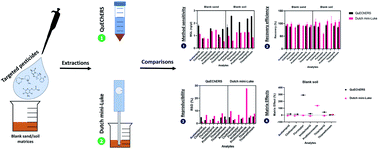Simultaneous determination of pesticides from soils: a comparison between QuEChERS extraction and Dutch mini-Luke extraction methods†
Abstract
The expanding nature of the agricultural sector has fuelled the intensification of plant protection products usage, including pesticides. These pesticides may persist in soils, necessitating their accurate determination in a variety of soil types. However, due to their complex nature, the effective extraction of pesticide residues from soil matrices can present challenges to pesticide detection and quantification. This research compared two well-known extraction methods, QuEChERS and Dutch mini-Luke, by assessing their specificity, sensitivity, accuracy, precision and reproducibility in extracting seven distinct pesticides with a range of chemico-physical characteristics from Irish soils. The HPLC-UV conditions were optimised to separate the seven pesticides, and it was shown that both extraction methods successfully extracted neonicotinoids with recovery values ranging between 85 and 115%. Fluroxypyr and prothioconazole could not be efficiently extracted using QuEChERS, however, the recovery values of both the analytes ranged between 59 and 117% using Dutch mini-Luke. Furthermore, with the exception of prothioconazole using Dutch mini-Luke, both extraction methods resulted in reproducibility and precision values below or equal to 20%. Lastly, Dutch mini-Luke is noted to have a lower matrix effect than QuEChERS, except for prothioconazole. The comparison results showed that Dutch mini-Luke resulted in superior method sensitivity, better recovery, and lower matrix effect towards most investigated analytes and was the only extraction technique that successfully extracted all pesticides analysed in soil matrices.



 Please wait while we load your content...
Please wait while we load your content...